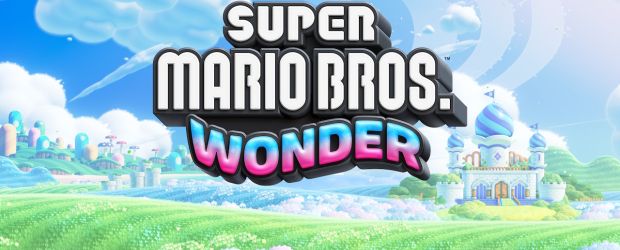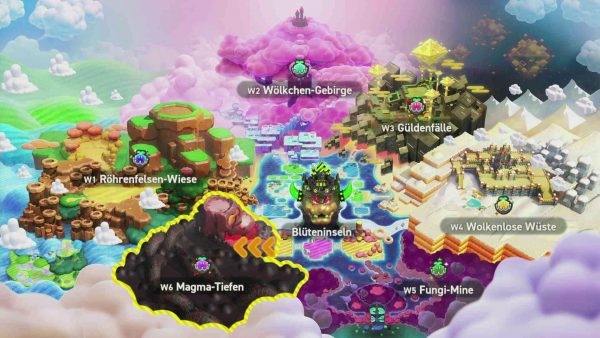Switch to: German
A decade after the last official 2D Super Mario platformer for home consoles, Super Mario Bros. Wonder aims to set a new standard for the genre.
Super Mario Bros. Wonder was released a week ago for the Nintendo Switch, a mere 11 years after New Super Mario Bros. U for the Wii U. In Europe, it is the fastest-selling Super Mario game of all time, Nintendo announced yesterday on Social Media. We played the platformer from start to finish for you and checked how good the new Super Mario game actually turned out.
As in many iterations of the series, the story is quickly summarized: Bowser, the king of the turtle-like Koopa, threatens the flower kingdom and quickly transforms into a dark castle. You’re tasked, alongside Prince Florian, to use the royal seeds scattered across the kingdom to eliminate the six ghost piranhas defending the castle and defeat Bowser in an epic finale.
The Flower Kingdom consits of six worlds as well as the Flower World, a hub world connecting every world, and a special world high above the clouds that you unlock towards the end of the game. While we have to unlock the individual worlds on the overworld, we can always freely choose between a couple of levels within each world. A whopping 152 levels await jump’n’run connoisseurs, including classic sections in which we have to make it to the finish flag (about half of the levels), also fairly similarly designed and mostly unchallenging boss fights against Bowser Jr., Wiggler Races, Badge Challenges, KO Arenas, Search Parties and Break Times. Super Mario Bros. Wonder includes eleven playable characters: Mario, Luigi, Peach and Daisy only differ in their appearance. However, if you choose the Yellow or Blue Toad, Toadette, Yoshi, the Red, Yellow or Light-Blue Yoshi or Nabbit, you can no longer die, but you can’t pick up any power-ups either.
The classic levels offer a lot of variety, as not only do the environments change in each world, from green meadows to lava caves, but almost every level is given its own twist. In musical levels we have to jump to the beat, which also includes the Break Times in which we listen to modernised Super Mario melodies and hop along, or certain badges with which let us collect extra coins by staying in the rhythm. In Wiggler Races, you have to finish before the caterpillar that gives it its name, which is a good challenge since the game puts all sorts of obstacles in your way while the camera scrolls automatically – a nice contrast to the Break Times. Otherwise, you hardly have to struggle with time pressure unless you want to get more coins in the Battle Parties. Here it is important to eliminate certain types of opponents as quickly as possible on up to four levels. We can choose between the four power-ups that are also available in the other levels: Fire Flower, Bubble Flower, Drill Mushroom and Elephant Fruit. Each power-up has individual advantages: While we use the Fire Flower to quickly eliminate enemies on the ground, the new Bubble Flower is ideal for eliminating opponents in the air or building your own platforms to reach hidden areas and get extra coins. The new Drill Mushroom allows us to drill under all kinds of surfaces, including the ceiling. With the Elephant Fruit we transform into a pachyderm and are able to tear down walls, throw enemies into the distance and spill water to get a lot of gold coins or to satisfy the talking flower that constantly accompanies us.
There are 24 badges to collect in Super Mario Bros. Wonder, which are divided into three types and which you either buy in shops for purple coins or for which you complete special Badge Challenges. Action Badges include helpful gadgets such as the Parachute Cap, which allows us to float over abysses, the Grappling Vine serves as a grappling hook and also lets us overcome long distances, or a Boosting Spin Jump. Boost Badges include Con Reward, a Safety Bounce saves us from boiling lava and the Sensor supports us in finding Wonder Flowers and 10-flower coins more easily, and Expert Badges give you access to Jet Run, Spring Feet and Invisibility. Before each level begins, we choose the appropriate badge. In rare cases, the game will also recommend a specific badge. Only one badge can be equipped at a time. Nintendo wanted to differentiate the game from The Legend of Zelda. The new superpowers fit well into the classic Mario gameplay and, together with the new badges, offer the opportunity to complete levels in different ways. However, we rarely went back to a level to change the badge.
In the classic level we can collect a golden flag by jumping to the top of the flagpole, as well as collect a fluctuating number of Wonder Seeds and 10-flower coins. We also pick up numerous purple flower coins and gold coins. 100 gold coins give us an additional life. We use flower coins to buy additional lives, badges or Standee Surprises for multiplayer mode in shops. Wonder Seeds unlock castles and access to new worlds. A big new feature of Super Mario Bros. Wonder are the Wonder Flowers, which are sometimes more, sometimes less well hidden and oftentimes fundamentally change or literally turn the level architecture and the way you interact with the level upside down. For example, we transform into a Goomba, the little brown creatures that we used to kill en masse on the Super Nintendo, ride into the night sky on a horde of wild ghostly Gallopteros or immerse the level in a Limbo-like black and white look to orientate ourselves solely through the eyes of the moving platforms. Combined with the Drill Mushroom, we transform into a red Jell-O Mario that sticks to all surfaces and experience some of the most creative puzzles in a Mario game. The Wonder Flowers are responsible for some of the most beautiful moments we’ve experienced in Super Mario Bros. Wonder.
During the approximately ten hours we spent playing the game, we also found numerous references to other Nintendo characters. In Search Parties you’re tasked with finding hidden Wonder Tokens. These puzzles gave us a lot of headaches. This is where the new power-ups really come into their own. We would have liked to have found more than the available handful of Search Party levels in the game. We also meet puzzle expert Captain Toad from Captain Toad’s Treasure Tracker at one point or another in the game.
The platformer has both a local drop-in/drop-out multiplayer mode for up to four players, in which all characters are crammed onto one screen, and an online mode in which we see the ghosts of other players and use Standee Surprises to warn each other about traps or point out hidden gems. We’re able to reward successful clues with likes and thus increase our online rank, similar to Death Stranding. Both multiplayer variants can help you in tricky areas, as you don’t die immediately after a mistake, but respawn in a bubble and can be brought back into the game by other players. The already high sensory overload reaches its peak with four players and is unlikely to enrich the gaming experience for everyone. The local multiplayer mode is suitable for experiencing the game with little siblings playing as an indestructible Yoshi, but less for serious platforming enthusiasts.
Super Mario Bros. Wonder is a technical masterpiece: The game runs smoothly at 1080p and 60 frames per second, aside from a few minor frame rate fluctuations in the overworld, and looks fantastic. The environments are bursting with detail, the levels are oftentimes huge and the animations are buttery smooth. The only detail that shows that the Nintendo Switch has slowly reached its limit is the character sprites, which are very nice but have visible jagged edges, especially on the overworld. The loading times are mostly short and crisp. In handheld mode, the game runs equally stable at 60 frames per second at a resolution of 720p.
The soundscape is in no way inferior to the visual presentation: While the soundtrack consists of a mixture of classic and new orchestral themes, Patapon-like vocal interludes and impulsive tracks which could be in games like Hotline Miami, Kevin Afghani does a great job as the new voice actor for Mario and Luigi and successor to Charles Martinet and the talking flower, which we initially expected to be quite annoying at some point, fits well into the game design and even provides a laugh or two. The classic sound effects have been supplemented with new variations and, together with the great music, ensure a great audiovisual experience.
Conclusion
Super Mario Bros. Wonder is a fantastic beautiful 2D platformer with sophisticated level design and brings in sensible innovations like the Wonder Flowers. In about ten hours you have already seen almost everything about the game. We’d have liked to see a few additional levels per world. However, it is possible that filler material was deliberately avoided and only the best levels made it into the game. The level of difficulty is generally set quite low and in the special world, experts will probably be challenged for the first time in the game. We can recommend Super Mario Bros. Wonder to all Nintendo Switch owners and platforming fans without hesitation.
We captured the screenshots on the Nintendo Switch in docked-mode. The publisher provided us with a review copy of Super Mario Bros. Wonder.














